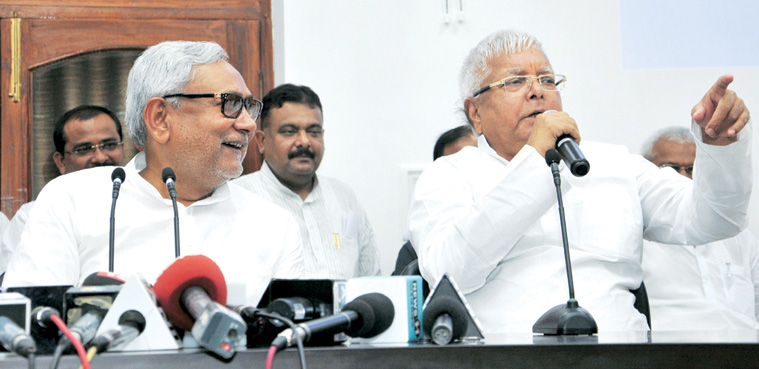Stay updated with the latest - Click here to follow us on Instagram
NDA loses lead after late surge in favour of Nitish Kumar-Lalu Prasad in Bihar: Post-poll survey
Pre-poll survey gave NDA lead of 4%; post-poll trends show Grand Alliance leading; Lalu did better than Nitish.
 Nitish Kumar (left) with Lalu Prasad Yadav. (Express photo by Prashant Ravi)
Nitish Kumar (left) with Lalu Prasad Yadav. (Express photo by Prashant Ravi)
As the guessing game over Bihar comes to a close this Sunday, initial trends emerging from the post-poll survey done by Lokniti-CSDS (not an exit poll) for The Indian Express, indicate a distinct turnaround in favour of the Mahagathbandhan.
A couple of weeks before the first phase of polling, the NDA was ahead in the electoral race in Bihar. The Lokniti-CSDS pre-poll survey for The Indian Express estimated a lead of 4 per cent for the NDA over the Mahagathbandhan. The five weeks of campaign seems to have brought small but significant changes.
The NDA seems to have slipped while the Gathbandhan seems to have gained momentum and taken a lead over the NDA. As per our post-poll estimate, the Gathbandhan seem to have a lead of 4 per cent over the NDA. The Mahagathbandhan may end up with roughly 42 per cent of the votes while the NDA would have to lag behind with around 38 per cent votes.
Watch Video: Lokniti-CSDS Bihar Post Poll Shows Turnaround In favour of Nitish-Lalu
[related-post]
The smaller parties and independents together might end up with 20 per cent votes. This lead could result in a major headline on Monday.
The post-poll study was conducted at 240 locations spread across 60 Assembly constituencies. A total of 3939 voters were interviewed. We are reasonably confident that the direction of the result would be as indicated by the post-poll survey. What is more crucial at this stage is the fact that with a contest as close as this, the outcome in terms of seats would definitely remain a suspense till Sunday afternoon.

Our analysis to be presented in these pages next week will come up with more details but it is necessary that we briefly discuss here the central puzzle: how did people’s choice change over the last five weeks or so?
Obviously, the most visible answer to this question is campaign. This election would certainly go down as one where the campaign proved to be critical. The difference in outcomes of the two surveys is also because (as the post-poll survey found) many voters finally made up their mind very late. While one fourth made up their mind either on the day of voting or a day or two before it, another 15 percent decided who to vote for only after seeing the candidates.
Rarely in any elections in the recent past, has such a large proportion of voters taken their voting decision at the very last minute. The survey found that the late swing of voters benefited the Mahagathbandhan. In many ways, this has been an election of several paradoxes.
As we had noted in the pre-poll analysis, the Mahagathbandhan began with a goodwill in favour of Nitish Kumar. At the same time, the central figure campaigning for NDA, Prime Minister Narendra Modi too, had a very robust positive image. So, it has been a contest between the state level leader and the national level leader.
Another paradox is that while Nitish Kumar’s popularity and developmental record has certainly helped the Mahagathbandhan do well, it is Lalu Yadav’s RJD which is likely to do better than the JD(U) as per our post-poll survey.
Finally, in the main theatre of OBC politics since 1990s, a new configuration emerged during these elections: the Yadav-Kurmis on one side and the more backward sections on the other side. Whether the Mahagathbandhan managed to forestall this configuration is something we need to look into once the details of the post-poll are available.







